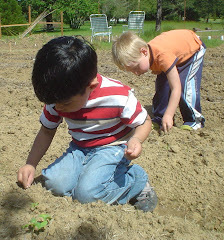Gardening is like any art-form. There are basic recipes and styles that most people agree on, and there's a lot of room for variation and personal adaptations to your own site and skills. These garden tips are our own 'best practices'; techniques that Chris has learned and adapted from others experience over his 40 years of growing food. We offer them as a starting place for the new gardener, and hope to offer a few new tips or variations that are of value to established gardeners. We welcome your comments and contributions to this blog. To contribute, go to: http://AlpineGarden.blogspot.com/
To prepare a bed for carrots, you need to dig down deep and really loosen the soil. Eighteen inches is optimal. Bust up any clods, or rake them off the surface till you have a flat, clodless, level bed.
We're using soaker hoses to get things started this year so we laid one down the center of the bed. This will water seedlings on both sides. When you lay out soaker hoses, it's best not to do it in lengths much more than 50 feet. The water pressure diminishes as you move down the hose and the plants at the tail end of the hose won't get as much water as those at the head. We have fashioned soaker hose clips (to hold them in place) with old plastic coat hangers we've clipped in the shape of hooks.
Take a stick or sharp trowel and create a groove in the soil on either side of the soaker hose.

Carrots don't like a lot of fertilizer but, since we're starting this garden from scratch, and the soil hasn't ever been built-up, we use a small amount, sprinkling lightly, of "All-Purpose" organic fertilizer. We get this from our local organic-supportive garden supply store. ('Down to Earth' is our favorite, in Eugene, OR) It has all the micro and macro nutrients needed for healthy plant growth, in a balanced form and it isn't too "hot"; it won't burn the seedlings as they grow like some uncomposted manures can.

The next step is to sow the seeds. Carrot seeds are quite tiny. The trick is to make a line of them with about one seed per inch. If they're spread much further, and some don't germinate, you'll have big gaps in your bed. If you sow them much thicker, you'll have a lot of thinning to do later (ultimately you want about an inch and a half between seedlings). Carrot seedlings are tiny, delicate little beings and easily confused with some kinds of weeds. So, save yourself trouble later and gently distribute them along the groove in an even, well-spaced manner.
Next, using the back edge of a garden rake, gently push 1/4 to 1/2 inch soil back over the seeds. They just want the merest covering so they don't have far to grow to get to the sunlight. The last step in planting is to tap the soil down on top of the seeds. Again, using the back of the rake, use a gentle tapping motion along the row. This helps settle the soil around the seeds and creates a groove for water to collect and nurture your young plants. Remove grass or dirt clods as you go, either break them up or pull them out of your row so the seedlings don't have to struggle to grow around or through them. Carrots like it easy. Here's a short video clip showing the technique we use for tamping down the soil:
Give your carrots a light watering with the sprinkler head of your hose. This too will help settle the seeds and give them a little head start in their germinating process. Don't over water. The seeds don't need much and if you water heavily you risk floating the seeds into clumps and undoing your careful job of spacing them along the row.
We hope you find these garden blogs informative and useful but we don't wish to burden your in-box. If you wish to be removed from our list, for any reason, please let us know: AlpineCoGarden@gmail.com
To prepare a bed for carrots, you need to dig down deep and really loosen the soil. Eighteen inches is optimal. Bust up any clods, or rake them off the surface till you have a flat, clodless, level bed.
We're using soaker hoses to get things started this year so we laid one down the center of the bed. This will water seedlings on both sides. When you lay out soaker hoses, it's best not to do it in lengths much more than 50 feet. The water pressure diminishes as you move down the hose and the plants at the tail end of the hose won't get as much water as those at the head. We have fashioned soaker hose clips (to hold them in place) with old plastic coat hangers we've clipped in the shape of hooks.
Take a stick or sharp trowel and create a groove in the soil on either side of the soaker hose.

Carrots don't like a lot of fertilizer but, since we're starting this garden from scratch, and the soil hasn't ever been built-up, we use a small amount, sprinkling lightly, of "All-Purpose" organic fertilizer. We get this from our local organic-supportive garden supply store. ('Down to Earth' is our favorite, in Eugene, OR) It has all the micro and macro nutrients needed for healthy plant growth, in a balanced form and it isn't too "hot"; it won't burn the seedlings as they grow like some uncomposted manures can.

The next step is to sow the seeds. Carrot seeds are quite tiny. The trick is to make a line of them with about one seed per inch. If they're spread much further, and some don't germinate, you'll have big gaps in your bed. If you sow them much thicker, you'll have a lot of thinning to do later (ultimately you want about an inch and a half between seedlings). Carrot seedlings are tiny, delicate little beings and easily confused with some kinds of weeds. So, save yourself trouble later and gently distribute them along the groove in an even, well-spaced manner.
Next, using the back edge of a garden rake, gently push 1/4 to 1/2 inch soil back over the seeds. They just want the merest covering so they don't have far to grow to get to the sunlight. The last step in planting is to tap the soil down on top of the seeds. Again, using the back of the rake, use a gentle tapping motion along the row. This helps settle the soil around the seeds and creates a groove for water to collect and nurture your young plants. Remove grass or dirt clods as you go, either break them up or pull them out of your row so the seedlings don't have to struggle to grow around or through them. Carrots like it easy. Here's a short video clip showing the technique we use for tamping down the soil:
Give your carrots a light watering with the sprinkler head of your hose. This too will help settle the seeds and give them a little head start in their germinating process. Don't over water. The seeds don't need much and if you water heavily you risk floating the seeds into clumps and undoing your careful job of spacing them along the row.
We hope you find these garden blogs informative and useful but we don't wish to burden your in-box. If you wish to be removed from our list, for any reason, please let us know: AlpineCoGarden@gmail.com





































No comments:
Post a Comment